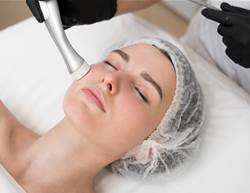The skin on your neck is thinner than the skin on your face and has a “lack of collagen compared with other areas of the body”, explains dermatologist Dr Dendy Engelman. “That’s why you start to see crepiness earlier on the neck, especially if you haven’t protected it with sunscreen, as UV rays can break down collagen,” adds dermatologist Dr Sabrina Fabi. “On the other hand, horizontal neck lines are a natural part of the anatomy, where skin attaches to the underlying muscle and, with time, starts to sag, folding over the lines,” she says. You may also notice laxity, including a double chin (this can be genetic) and jowls along the jawline, Dr Fabi says.
But keep your chin up! Top skin pros are here to share the best ways to smooth out your neck.
6 of the best tried and tested neck fixes
1. Sleep on your back
Avoiding lying on your chest or side when you doze could ward off wrinkles, because
skin is less likely to crease when not pressed into pillows. But getting sufficient sleep is most
important, Dr Fabi says. A lack causes levels of the stress hormone cortisol to increase, breaking down collagen and thinning skin. Aim for eight hours of rest per night and, if possible, sleep on a silk pillowcase, which reduces friction and stops your skin creasing while you snooze. We like Silvi ($89,au.mysilvi.com), which is treated with silver ions to reduce bacteria and support good skin health.
2. Stop staring at your phone
Constantly looking down at your phone can cause ‘tech neck’ – premature neck lines or sagging – to develop over time. “This condition results from persistent folding of the skin when looking down at a phone or a laptop,” Dr Engelman says. To prevent and minimise tech neck, position your gadget at eye level, Dr Fabi suggests. And sit up straight. “Good posture will stop you hunching over, which can exacerbate sagging and lines,” she says. “Exercises, such as Pilates, can help improve posture by strengthening spine muscles.”
3. Cleanse gently
“You should wash your neck skin with as much care as you do your face,” Dr Fabi says. “The particulate matter in air pollution can sit on skin and accelerate ageing, and daily cleansing is necessary to remove it.” That said, treat it like baby skin and avoid using harsh scrubs and peels on the neck, as they can induce inflammation and actually worsen signs of ageing, she advises.
4. Use face products on your neck, too
Smooth your daily skincare products, such as anti-ageing serums and moisturisers and broad-spectrum SPF 50+ sunscreen, on your neck and chest as well to hydrate and fortify the area and protect against sun damage. “Sunscreen filters UVA and UVB rays to prevent them from breaking down collagen, which can cause sagging,” Dr Fabi explains. And while prevention is key, treatments such as serums and moisturisers “can also be used to help thicken papery skin”, Dr Engelman says.
5. Try a neck specific treatment
You don’t need a separate anti-ageing neck product, Dr Fabi says, as long as you apply the skincare you use for your face there also. But if you have noticeable issues, you may want to consider one, as they’re specifically formulated for the needs and tolerance of the neck skin.
6. Choose ingredients carefully
When it comes to anti-ageing treatments, certain ingredients can be more harmful than helpful for the neck. “The gold standard is retinol,” Dr Fabi says, “but it can sometimes irritate fragile skin.” Try treatments with gentler proven line reducers and firmers, such as peptides and growth factors. “The neck doesn’t have as many stem cells for skin to create more collagen, so growth factors give skin cells signals to produce it,” she says.
Bringing in a pro
If you want more drastic, non-invasive results, see a dermal therapist or dermatologist. “Non-ablative laser therapy can work well on rebuilding the skin and tightening collagen,” says dermal therapist Dr Giulia D’Anna. “It works by heating the cells that produce collagen, thereby speeding up production, and heating the collagen to ‘shrink’ it and make it tighter.” Most people will need three to six treatments; expect to pay around $300 and up. “Other treatments, such as Thermage (using radiofrequency) and Ulthera (using ultrasound), work by using intense heat energy to contract the skin, tightening the overall appearance,” adds Dr Giulia. “Generally speaking, ultrasound can penetrate deeper than radiofrequency, so technically will give a better result.” But be warned – it can be painful. These treatments aren’t cheap either, so expect to pay anything between $1000 to $5000 each, depending on the size of the treatment area.










